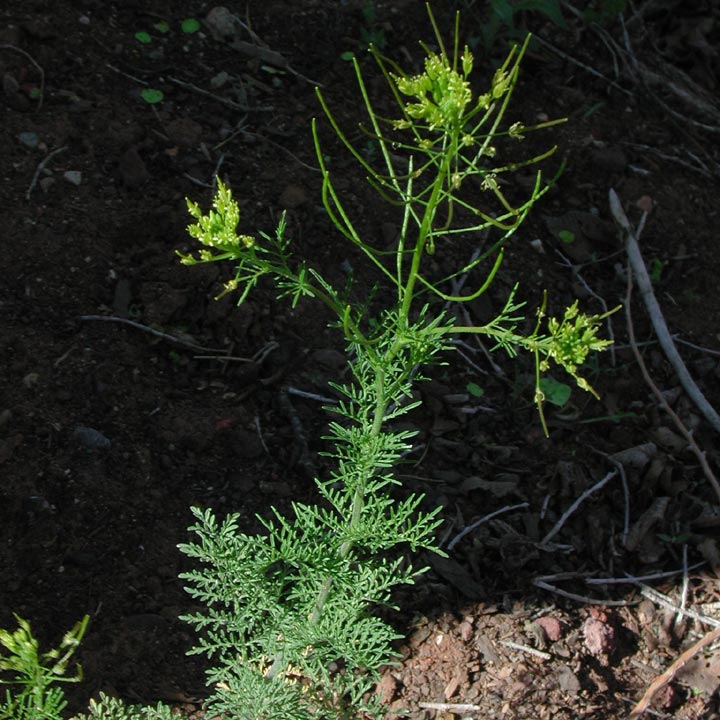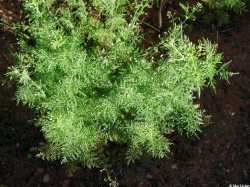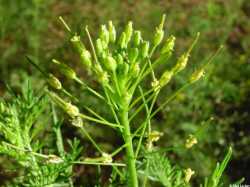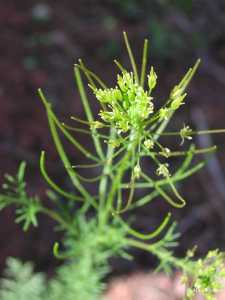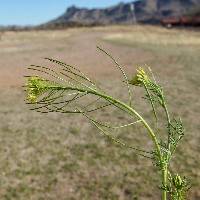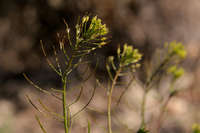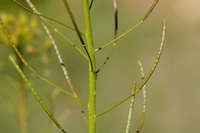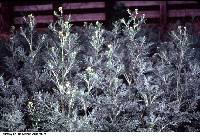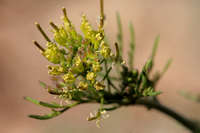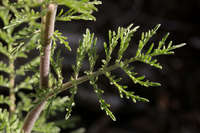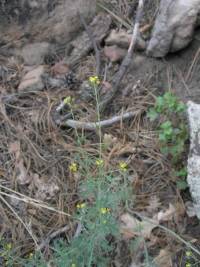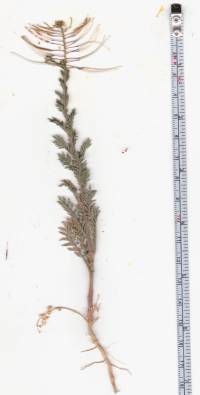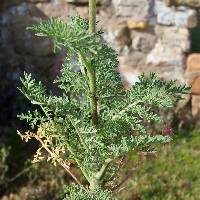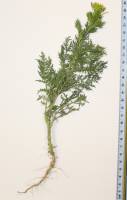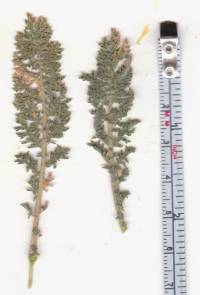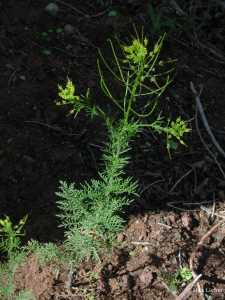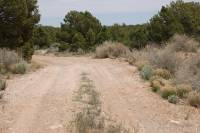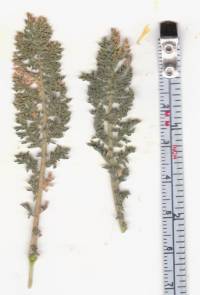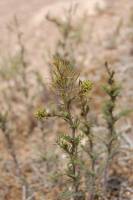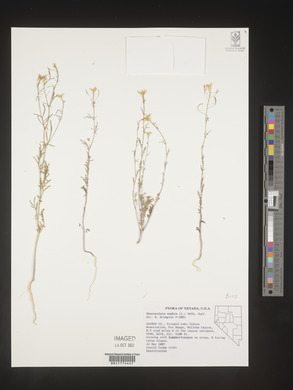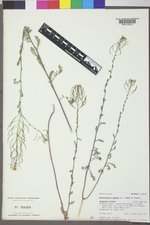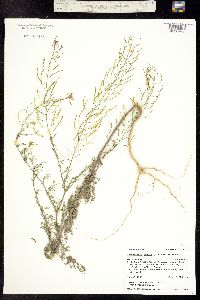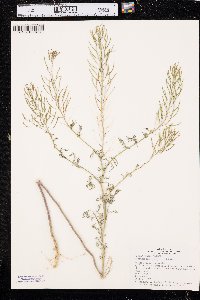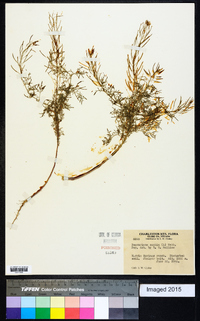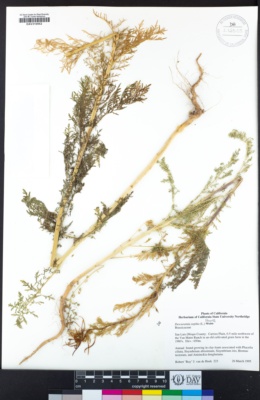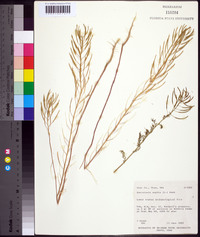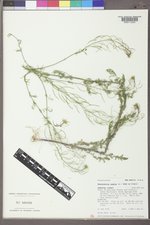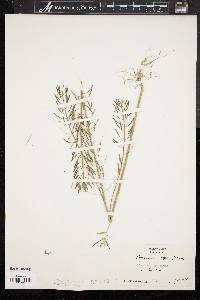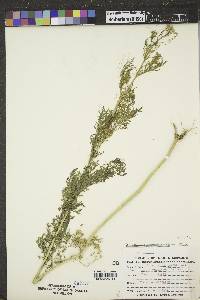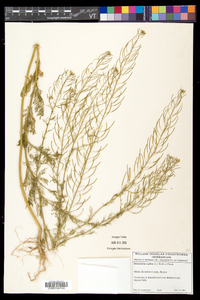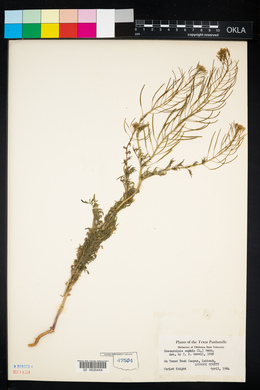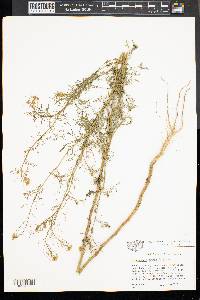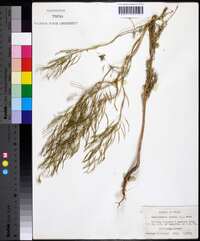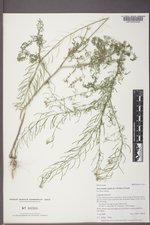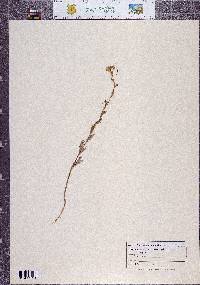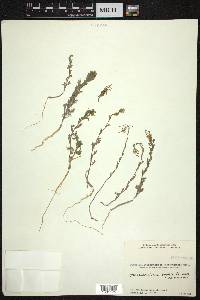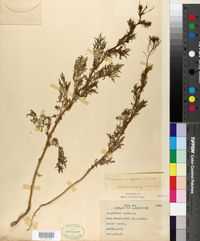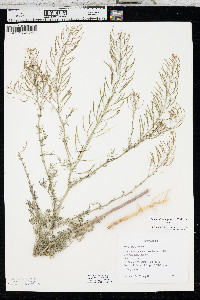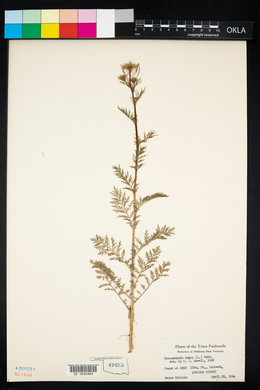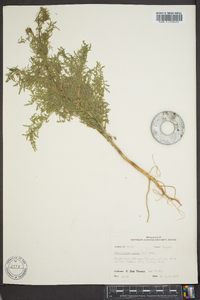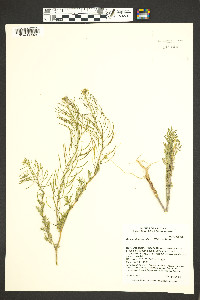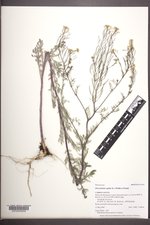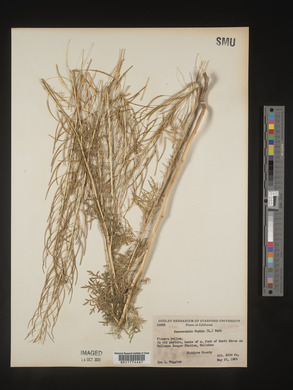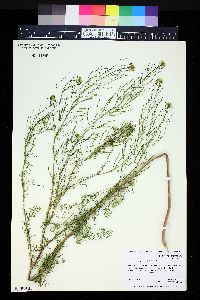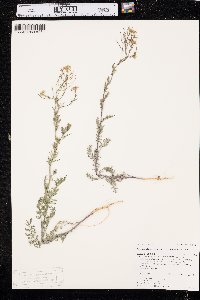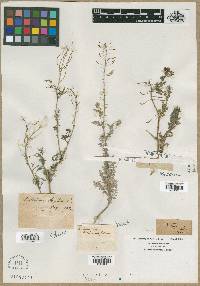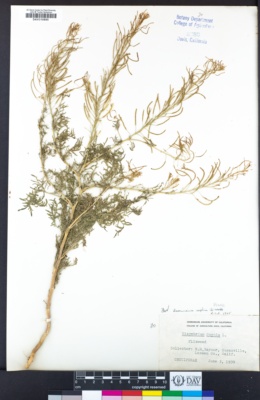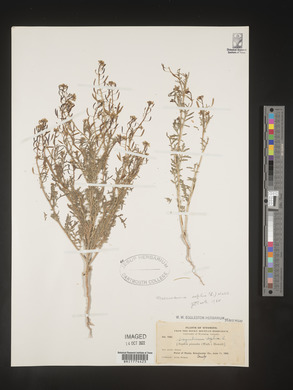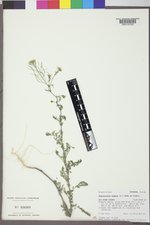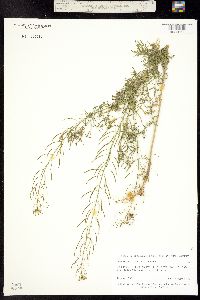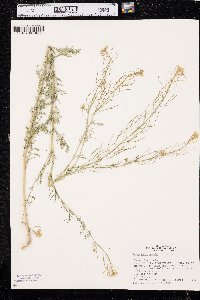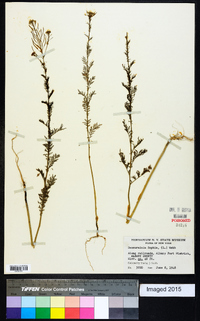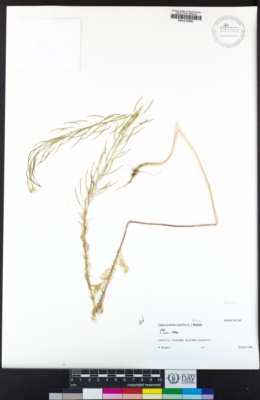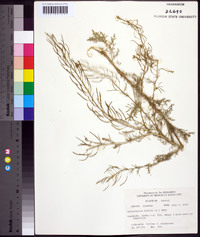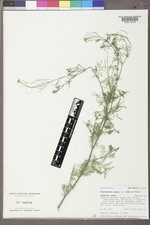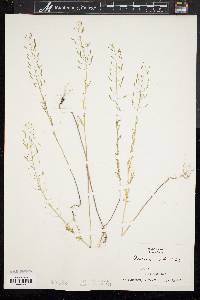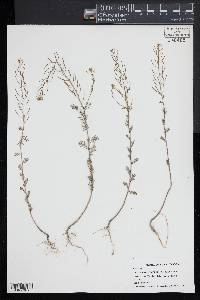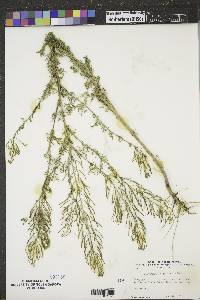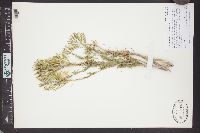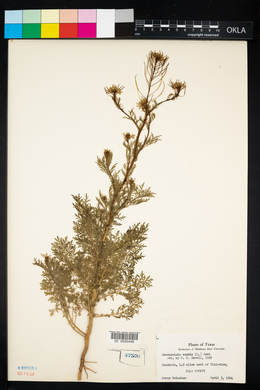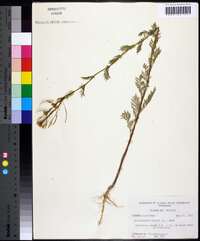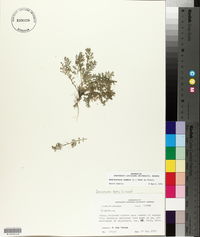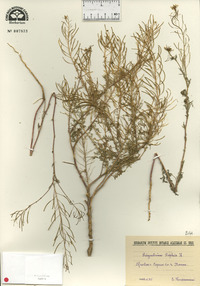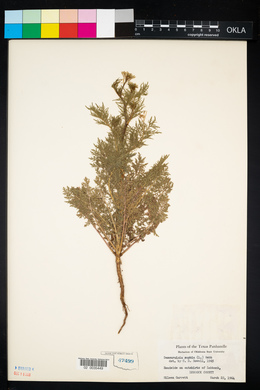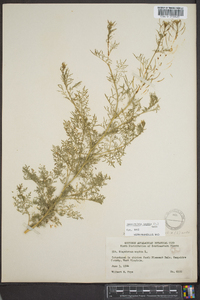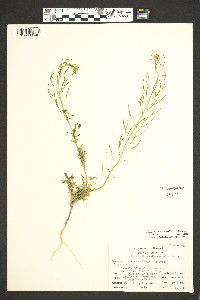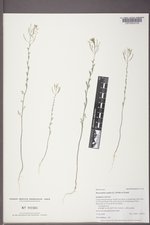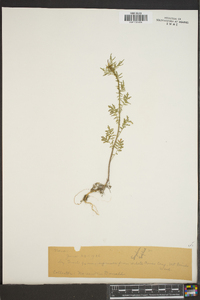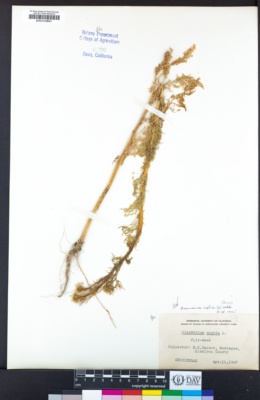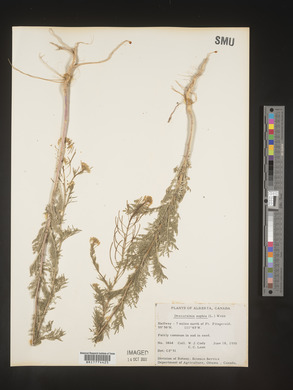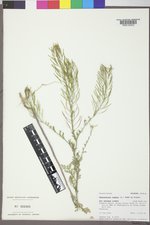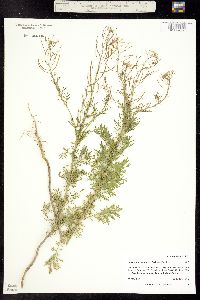Descurainia sophia
|
|
|
|
Family: Brassicaceae
Herb-Sophia, more...fluxweed, flixweed tansymustard, flaxweed tansymustard, flixweed, herb sophia, pinnate tansymustard, tansymustard
[Sisymbrium parviflorum Lam., moreSisymbrium sophia L., Sophia sophia (L.) Britt.] |
Annuals; eglandular; sparsely to densely pubescent, sometimes glabrous distally, trichomes dendritic. Stems erect, un-branched or branched distally, (1-)2-7(-10) dm. Basal leaves: petiole 0.1-2(-3) cm; blade 2- or 3-pinnate, ovate or oblong to obovate in outline, to 15 cm, lateral lobes linear or oblong, (to 10 × 2 mm), margins entire. Cauline leaves sessile or shortly petiolate; blade smaller distally, distal lobes often narrower, surfaces often glabrous. Racemes considerably elongated in fruit. Fruiting pedicels divaricate to ascending, straight, (5-) 8-15(-20) mm. Flowers: sepals erect to ascending, yellowish, oblong, 1.8-2.8 mm, glabrate to sparsely pubescent; petals narrowly oblanceolate, 2-3 × 0.4-0.6 mm; median filaments 2-3 mm; anthers 0.3-0.4 mm. Fruits divaricate-ascending to erect, narrowly linear, torulose, (12-)15-27(-30) × 0.5-0.8(-1) mm, (straight or curved upward); valves each with distinct midvein; septum with a broad central longitudinal band appearing as 2 or 3 veins; ovules 20-48 per ovary; style obsolete, 0.05-0.2 mm, glabrous. Seeds uniseriate, reddish brown, oblong, 0.7-1.3 × 0.3-0.6 mm. 2n = 28. Flowering Mar-Jul. Roadsides, waste places, disturbed sites, railroad embankments, hillsides, mountain slopes, canyon bottoms, stream banks, fields, lawns, pastures, deserts, sagebrush and pinyon-juniper communities; 0-3000 m; introduced; Alta., B.C., Man., N.B., Nfld. and Labr. (Nfld.), N.W.T., N.S., Ont., P.E.I., Que., Sask., Yukon; Alaska, Ariz., Ark., Calif., Colo., Conn., Del., D.C., Ga., Idaho, Ill., Ind., Iowa, Kans., Ky., La., Maine, Mass., Mich., Minn., Mo., Mont., Nebr., Nev., N.H., N.Mex., N.Y., N.C., N.Dak., Okla., Oreg., Pa., R.I., S.Dak., Tenn., Tex., Utah, Vt., Va., Wash., W.Va., Wis., Wyo.; Eurasia; introduced also in Mexico, Central America, South America, South Africa, Australia. Deviant chromosome counts (e.g., 2n = 12, 14, 20, 38; see R. C. Rollins 1993, N. H. Holmgren 2005b, S. I. Warwick and I. A. Al-Shehbaz 2006) are most certainly erroneous, and the species appears to be exclusively tetraploid based on x = 7.
Annual or biennial herb with a thick taproot 30 cm - 0.8 m tall Leaves: alternate, two to three times pinnately divided, stalkless, to 14 cm long, to 7 cm wide, becoming smaller upward, with star-shaped hairs. Leaf segments linear or narrowly reverse lance-shaped. Flowers: in a loose, branched cluster (raceme), which is borne terminally on a stem. Sepals four, yellowish green, linear. Petals four, yellow, small (flowers 3 mm wide), spatula-shaped, slightly recurved. Stamens six. Fruit: a long, narrow pod (silique), on a thin, widely ascending stalk (stalks to 1.5 cm long), 1.5 - 2.5 cm long, 0.5 - 1 mm wide, linear. Seeds in one row in each chamber, 12 to 25 seeds per row. Stems: multiple, upright, branched above, densely whitish-hairy (some of the hairs star-shaped). Similar species: Descurainia pinnata ssp. brachycarpa is similar but has shorter pods, hairy-glandular stems, and slightly less divided leaves. Flowering: mid-May to early July Habitat and ecology: Introduced from Europe. Occurs sparingly in waste ground and along railroads. It is also found growing as a barnyard weed. Occurence in the Chicago region: non-native Etymology: Descurainia is named after the 18th Century French botanist and physician Francois Descourain (1658-1740). Author: The Morton Arboretum FNA 2010, Correll and Johnston 1970, USDA GRIN, Heil et al 2013 Duration: Annual Nativity: Non-Native Lifeform: Forb/Herb General: Annual herb, 25-75 cm tall, from a taproot; stems unbranched or branched distally, sparsely to densely pubescent with dendritic hairs. Leaves: Basal leaves short-petiolate; stem leaves alternate and sessile or short-petiolate; blades 2-9 cm long, 2-3 times pinnate, the ultimate divisions linear. Flowers: Yellow, in terminal racemes on pedicels 8-15 mm long which are ascending in flower and spreading to ascending when in fruit; sepals 4, erect to ascending, yellowish, 2-3 mm long; petals 2-3 mm long, yellow. Fruits: Capsules linear, 1-3 cm long, often curved, slightly constricted between the seeds, loosely ascending to erect; seeds numerous, 1 mm long, reddish brown, in one row per locule. Ecology: Found on open and disturbed ground from 3,000-7,500 ft (915-2285m); flowers April-June. Distribution: Native to North Africa and Eurasia; Introduced to South Africa, Australia, S. Amer., N. Amer. In every US state except FL. Notes: Descurainia is a genus of weedy-looking mustards with feathery, pinnately lobed leaves, racemes of inconspicuous white to yellow flowers, and narrow seed pods. The raceme is compact when in flower and then expands substantially in fruit so that the seed pods are well-spaced along the stalk. To distinguish among the various species of Descurainia, focus on the shape, size, and orientation of the seed pods. D. obtusa has straight, narrow (1 mm wide), linear seed pods 1-2 cm long which are slightly constricted between the seeds and can be horizontal or upward pointing. D. pinnata has seed pods which are a bit wider and rounded at the tip compared to the base (clavate, or club-shaped), about 1 cm long, not constricted between the seeds, and the pods point upwards even though the pedicels tend to be more horizontal or only slightly upward pointing. D. sophia is more similar to D. obtusa; like D. obtua it has ascending-spreading pods which are narrow and slightly constricted between the seeds; however the pods are glabrous, tend to be slightly longer (1.5- 3 cm long), and the pods themselves tend to curve a bit upward at maturity (D. obtusa has almost completely straight pods). D. sophia is an exotic species, often found in dry and disturbed areas. It produces exceptionally large seed crops, which can lead to its dominance at sites as well as helping it re-establish rapidly after a fire. Host plant for Checkered White and Beckers White butterflies. Ethnobotany: Edible greens and seeds. Tansy mustard appears in clan names and migration tales as an important plant. Etymology: Descurainia is named for French pharmacist and botanist Franscois Descourain (1658-1740); sophia translates to wisdom. Synonyms: Sisymbrium sophia, Sophia sophia Editor: SBuckley 2010, FSCoburn 2015, AHazelton 2015, AHazelton 2017 Erect, 3-8 dm, canescent throughout; lvs ovate to obovate or the upper narrower, 2-3 times pinnatifid into linear or narrowly oblanceolate segments; fls 3 mm wide; mature racemes loose, with widely ascending pedicels 8-14 mm; frs narrowly linear, 15-25 נ0.5-1 mm; septum with longitudinal veins; seeds in each locule (12-)15-25, in one row; 2n=28. Native of Eurasia, established as a weed in fields and waste places throughout most of the U.S. and s. Can. May-July. (Sophia s.; S. multifida; Sisymbrium sophia) Gleason, Henry A. & Cronquist, Arthur J. 1991. Manual of vascular plants of northeastern United States and adjacent Canada. lxxv + 910 pp. ©The New York Botanical Garden. All rights reserved. Used by permission. |
|
|
|

